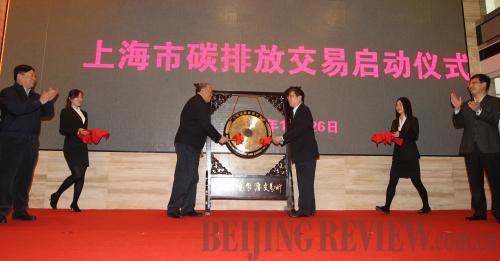|
 |
|
INAUGURATION: Shanghai launches its carbon emissions trading market on November 26, 2013 (PEI XIN) |
Tianjin, a port city in north China, launched the country's fifth regional carbon emissions trading (CET) market on December 26, 2013. According to the Tianjin Climate Exchange which hosts the market, a total of 4,040 permits were traded on the first day at an average price of 29.78 yuan ($4.86), with PetroChina Co., the country's largest oil and gas producer, included among the buyers. Each permit gives the owner the right to discharge 1 ton of carbon dioxide.
An initial 114 companies from power, iron and steel, chemical, petrochemical and gas extraction industries were included under the quota allocation. The companies included have collectively emitted more than 20,000 tons of carbon dioxide since 2009.
Emissions trading is a widely adopted method of putting a price on carbon dioxide produced by burning fossil fuels such as coal and gas.
Under the program, factories and other major carbon producers will be forced to cap the volume of their emissions. Cleaner companies will be able to sell excess permits to dirtier ones, allowing the market to set a price that can help to reduce the overall emissions.
As the highest emitter of carbon dioxide, China has pledged to reduce its carbon emissions up to 45 percent per 10,000 yuan ($1,650) of its GDP, compared to recorded levels in 2005. By 2020, carbon trading is seen as a key tool in helping achieve that target.
"The trial CET markets will not only allow China to cut carbon emissions overall but they will also help industrial restructuring," said Xie Zhenhua, Vice Minister of the National Development and Reform Commission (NDRC), China's top economic planner.
According to Xie, China intends to create a national CET system by 2015, following the experience gained through regional trials.
The establishment of CET markets in China was carried out in July 2010, when Shenzhen, seven other cities and five provinces were named the sites of China's first low-carbon emissions programs. Two months later, the country's first CET platform, the China Emissions Exchange (CEE), was founded in Shenzhen, south China's Guangdong Province.
Regional pilots
The move from low-carbon emissions programs to carbon trading came in 2011, when the NDRC approved pilot trading plans in five cities—Beijing, Tianjin, Shanghai, Chongqing and Shenzhen—as well as the provinces of Hubei and Guangdong. One year later, the Standing Committee of the Fifth People's Congress of Shenzhen put the country's first regulations regarding the administration of carbon emissions into action.
On June 18, 2013, China's first regional market for compulsory carbon trading was launched in Shenzhen after nearly three years of preparations.
According to the CEE, the Shenzhen CET program covers 635 industrial companies and 197 public buildings that together account for 40 percent of the city's carbon emissions. Carbon intensity, measured as the volume of emissions per 10,000 yuan of China's GDP, emitted by the industrial companies covered are estimated to drop by 32 percent by 2015 compared to 2010 levels.
Following Shenzhen, four other areas— Shanghai, Beijing, Guangdong and Tianjin—also established similar programs between November and December 2013. Chongqing and Hubei are expected to launch their own CET markets later this year.
"The launch of the CET system means that a maximum volume will be set for carbon dioxide emissions in an area, which will drive local governments and companies to limit their emissions in order to reach the fixed targets," said Chen Hongbo, Deputy Director of the Research Center for Sustainable Development with the Chinese Academy of Social Sciences.
Chen believes that emission rights are corporate assets. "Trading is actually based on the concept of property rights. With a clear definition of emission rights, the CET system will do immense good for the country, its enterprises and its citizens in the future," he commented.
Su Wei, Director of the NDRC's Department of Climate Change, said that the seven areas were carefully chosen, because they vary in their levels of economic development, industrial structure as well as residents' environmental protection awareness.
"Shenzhen, which is already a harbor for hi-tech and environment-friendly enterprises, will further raise the market entry threshold and reject energy-hungry and high-polluting companies. But for the less-developed western city of Chongqing, the government has to persuade its heavy industries to balance profit growth and environmental protection," Su said.
Qi Shaozhou, a professor at the Economics and Management School of Hubei-based Wuhan University, said the emissions trading scheme in Hubei will set an example on how to lift people out of poverty while curbing pollution for the parts of western and central China still learning to balance the two.
"It will also help regional governments, local enterprises and environmental protection organizations come to a consensus on ecologically sound development plans," Qi said.
On January 2 of this year, a report issued by the CEE showed that permits for discharging 190,000 tons of carbon dioxide had been traded under the Shenzhen CET program since its introduction, with trades reaching a total value of 13 million yuan ($2.12 million).
| 